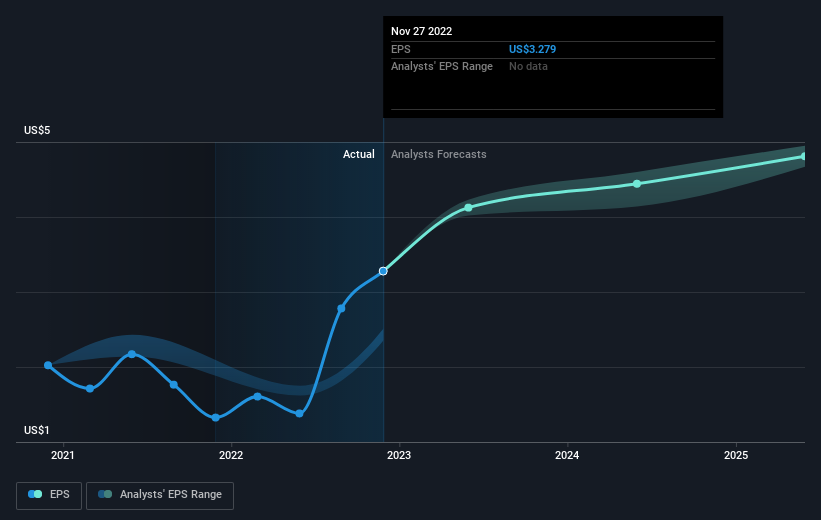- United States
- /
- Food
- /
- NYSE:LW
Investors one-year returns in Lamb Weston Holdings (NYSE:LW) have not grown faster than the company's underlying earnings growth

Passive investing in index funds can generate returns that roughly match the overall market. But one can do better than that by picking better than average stocks (as part of a diversified portfolio). To wit, the Lamb Weston Holdings, Inc. (NYSE:LW) share price is 93% higher than it was a year ago, much better than the market decline of around 8.9% (not including dividends) in the same period. So that should have shareholders smiling. Also impressive, the stock is up 84% over three years, making long term shareholders happy, too.
In light of the stock dropping 5.6% in the past week, we want to investigate the longer term story, and see if fundamentals have been the driver of the company's positive one-year return.
Check out our latest analysis for Lamb Weston Holdings
While markets are a powerful pricing mechanism, share prices reflect investor sentiment, not just underlying business performance. By comparing earnings per share (EPS) and share price changes over time, we can get a feel for how investor attitudes to a company have morphed over time.
Lamb Weston Holdings was able to grow EPS by 146% in the last twelve months. It's fair to say that the share price gain of 93% did not keep pace with the EPS growth. Therefore, it seems the market isn't as excited about Lamb Weston Holdings as it was before. This could be an opportunity.
You can see how EPS has changed over time in the image below (click on the chart to see the exact values).

We know that Lamb Weston Holdings has improved its bottom line lately, but is it going to grow revenue? You could check out this free report showing analyst revenue forecasts.
What About Dividends?
As well as measuring the share price return, investors should also consider the total shareholder return (TSR). The TSR incorporates the value of any spin-offs or discounted capital raisings, along with any dividends, based on the assumption that the dividends are reinvested. Arguably, the TSR gives a more comprehensive picture of the return generated by a stock. We note that for Lamb Weston Holdings the TSR over the last 1 year was 95%, which is better than the share price return mentioned above. And there's no prize for guessing that the dividend payments largely explain the divergence!
A Different Perspective
It's good to see that Lamb Weston Holdings has rewarded shareholders with a total shareholder return of 95% in the last twelve months. That's including the dividend. That gain is better than the annual TSR over five years, which is 13%. Therefore it seems like sentiment around the company has been positive lately. In the best case scenario, this may hint at some real business momentum, implying that now could be a great time to delve deeper. I find it very interesting to look at share price over the long term as a proxy for business performance. But to truly gain insight, we need to consider other information, too. Take risks, for example - Lamb Weston Holdings has 2 warning signs (and 1 which is potentially serious) we think you should know about.
If you like to buy stocks alongside management, then you might just love this free list of companies. (Hint: insiders have been buying them).
Please note, the market returns quoted in this article reflect the market weighted average returns of stocks that currently trade on US exchanges.
New: AI Stock Screener & Alerts
Our new AI Stock Screener scans the market every day to uncover opportunities.
• Dividend Powerhouses (3%+ Yield)
• Undervalued Small Caps with Insider Buying
• High growth Tech and AI Companies
Or build your own from over 50 metrics.
Have feedback on this article? Concerned about the content? Get in touch with us directly. Alternatively, email editorial-team (at) simplywallst.com.
This article by Simply Wall St is general in nature. We provide commentary based on historical data and analyst forecasts only using an unbiased methodology and our articles are not intended to be financial advice. It does not constitute a recommendation to buy or sell any stock, and does not take account of your objectives, or your financial situation. We aim to bring you long-term focused analysis driven by fundamental data. Note that our analysis may not factor in the latest price-sensitive company announcements or qualitative material. Simply Wall St has no position in any stocks mentioned.
About NYSE:LW
Lamb Weston Holdings
Engages in the production, distribution, and marketing of frozen potato products in the United States, Canada, Mexico, and internationally.
Good value with reasonable growth potential.
Similar Companies
Market Insights
Community Narratives




